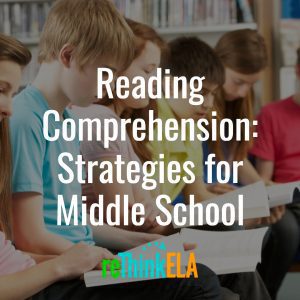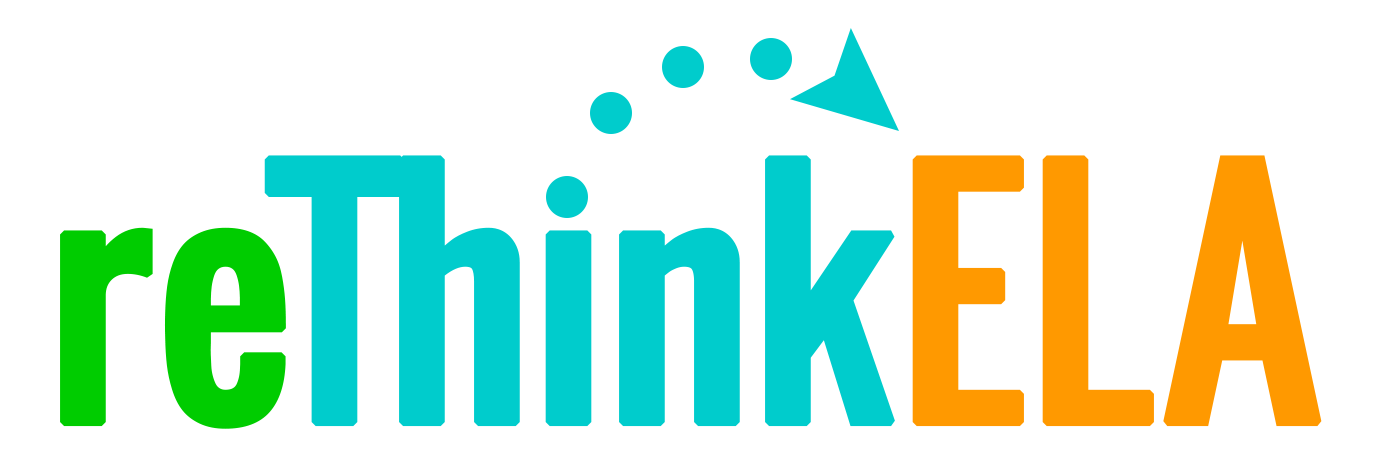
As a reader, I have used most, if not all of the reading comprehension strategies I’m about to discuss throughout my years as a student, as I’m sure all of you have. As a teacher, I have guided students through using these strategies during whole-class reading units.
Until last week though, I had not introduced my students to the the metacognitive element of thinking about the process of comprehension. It’s just been something we have done together, and I have not asked students to complete this process on their own, or in their small groups. That said, students who already comprehend on or above grade level typically already employ these strategies, though most likely at a subconscious level. Even if they have been explicitly taught these strategies (I am going to assume my 7th graders have), the actual process was probably long forgotten over the summer. Those students who are reading significantly below grade level may not have been taught this process, or perhaps didn’t comprehend the process itself the first few times around. In any case, it’s time to introduce it again.
This year, I have felt my reading instruction lacked depth. Yes, we covered the literary elements required in the Oklahoma PASS ELA Standards. Yes, we have used pre-reading strategies, learned about word origins,greek and latin word parts, and more. Yet, I felt something was missing.
I figured out what it is that we’re missing last week.
A colleague and I had the opportunity to go to the Oklahoma Association for Supervision and Curriculum Development fall conference, in which Lori Oczkus presented Comprehension and Guided Reading Strategies. Not only did she share the strategies (which I’m sure most of us knew about, as they are all over the educational corner of the internet), but she also shared some creative and engaging ways to teach these strategies to students, so that students can use them on their own, both in groups and independently.
This is the missing link, the part that excited me because (I don’t know about you…) I’m not going to going to hold my students’ hands forever. My goal is to put myself out of a job with each set of students each year. In other words, by the end of the year, my goal is for my students should be able to comprehend on-grade-level texts using these strategies, without my assistance.
While Lori presented seven comprehension strategies, she identified four, which she refers to as The Fab Four: Predicting, Questioning, Clarifying, and Summarizing. While each of these strategies need to be taught to the students by themselves, Lori recommends taking these up a notch by teaching students to use them in concert with one another, on the same reading material. In other words, students should cycle through these strategies each time they read fiction, nonfiction, or even an excerpt of a larger piece. Must like The Writing Process, these Reading Comprehension Strategies work best when students rotate through them, back and forth, to dig out the meat of the story or article.
Her presentation brought me back to reality:
The heart of reading education is not in learning literary elements, or meeting a standard on a reading test: It is understanding, and gaining meaning from the text itself. It is students digging deeply into whatever text is set before them, and pulling out gems of human understanding, author’s purpose appreciation, or knowledge comprehension.
By shepherding students from whole-class guided reading, through small-group strategy roles, to independent use of these comprehension tricks, I can return my classroom to its original purpose: to provide students with the tools they need to understand the world around them.
Sorry about the philosophical dump. I had to get that out of my system, both as a way to impress upon myself the importance of what I have learned, but to also share with others who may need to experience the same epiphany.
Lori provided us with visual representations for each strategy, including graphics, hand-signals, and costume ideas, She also guided us through each strategy and modeled a lesson using short reading passages her team had provided at the start of the workshop.
I’m not going to detail everything she said. You’ll need to attend your own workshop for that. However, below are links to other resources for the four strategies, along with more strategies you can use with your students.
First, here are The Fab Four:
Predicting
When predicting before reading, students begin by looking at the cover of a book, or headlines, subheads, graphics, and pictures of an article and predict/guess what they think the text is about, the purpose of the author, and the structure of the text. During reading, students may predict what is going to happen next, or what the author is going to say next. Sentence stems include: I think I will learn _____ because _____; I think _____ will happen because _____.
- Predicting with nonfiction
- Making predictions anchor chart with sentence frames (Did I mention that I’m an anchor chart junkie…?)
- Reading Clinic: Using predictions to help students think deeply about books
- Guided reading activities: Making Predictions
Questioning
When questioning, students create their own questions before, during and after reading. Students may use sentence stems such as: I know/see _____, so I wonder _____. Students can take statements from the text and turn them into questions, or use prior knowledge to create inferential questions.
- Teaching asking questions (elementary level — but includes wonderful anchor charts that will work at the middle school level)
- Questions to ask about reading (4th grade — but can be leveled up)
- List of sample questioning lesson plans
- Questions Answer Relationship lessons and activities
- Introducing Question Answer Relationships (QAR) for the first time (PPT): This PowerPoint introduces students to four levels of questions, ranging from questions in which the answers are explicitly stated in the text to questions in which the students must have background knowledge in order to answer. This information is particularly useful at the secondary level for teaching students to create higher order thinking questions before, during, and after they read.
- Introducing Question Answer Relationships (QAR) for the first time (DOC): This worksheet goes with the above PowerPoint, enabling students to design some of their own questions at each level, with teacher guidance.
- QAR Guide for Students (DOC): This guide will help students as they create their own questions, after receiving instruction and guidance from the two previous lessons.
Clarifying/Monitoring
When clarifying/monitoring, students become actively aware of their comprehension. They begin to recognize that they did not understand a word, a sentence, or even an entire section. Students then take action to gain the understanding that they need to fully comprehend the text. Sentence stems students can use during this step include: I didn’t get ____ so I _____. This is an important step to model to your class, and for higher level students to model in group work because it helps struggling readers see solutions to their comprehension dilemma.
- Monitor and clarify anchor chart (again, at the 4th grade level, but can be introduced to older students by guiding them through the process of helping you create the anchor chart)
- Monitor and clarify (VIDEO): Great for 6th grade and lower, this video not only defines monitoring and clarifying, but shows a student using these strategies.
- Use “Fix Up” Strategies anchor chart
- Signs of confusion anchor chart
Summarizing
Finally, after reading, students should be able to summarize what they have just learned. They can write one sentence (20 word tweet, for example), or even one word summaries. Students can use sentence stems such as: This is about _____; First _____, next _____, then _____, finally _____.
- CUSS and GIST analysis strategies
- Summarizing strategies (PDF)
- Summary organizer
- Strategies for Struggling Readers (PDF)
Reciprocal teaching strategy overviews
- Deeper Thinking, Deeper Reading (PREZI)
- Introduction to Reading Strategies by the Dade-Monroe Teacher Education Center
- Reading strategies overview printable
- Reciprocal teaching graphic organizer ($)
- Reading is thinking anchor chart
- Making connections using our schema
- Metacognition salad anchor chart (Pinterest)
- Another metacognition anchor chart
If you have any other ideas or resources that will help our community of English and Reading teachers, please share them in the comments below.

This is very helpful thank you!